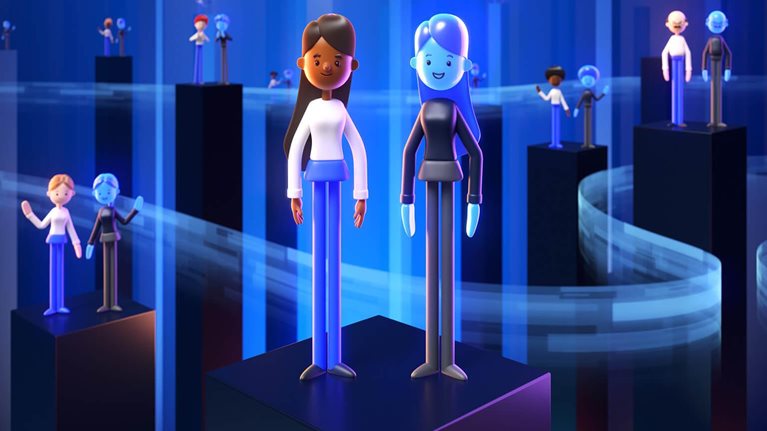How does the metaverse fit into your business strategy?
I think this idea of the metaverse as a connected sandbox where people can play and cross over from one place to another is key and lends itself to the core of LEGO’s mission that I still feel strongly about.
But, equally, in the same way that you wouldn’t want a child walking alone in one after midnight, you wouldn’t want the same thing to happen in the metaverse.
So, how can we build that in a way that allows kids to have these creative, social experiences that they deserve and want, but build it in a way from the ground up so we’re not trying to layer over it and fix it in the future.
My vision is closer to the more expansive idea of the metaverse as the next generation of digital engagement. Some think of it as the next generation of the internet, which I think may almost be a bit too broad. But it certainly should be a place where you can explore some kind of 3D space with a representation of yourself that crosses over from one experience to another and while maintaining certain attributes that link different experiences, both in the back end and front end. That, for me, is what the metaverse could and should be.
How will the physical and online worlds finally combine?
When the technology advances to a much lower friction form factor, whether it’s via glasses or something similar, that’s when augmented reality (AR) will really start to take off.
I’m talking about the point when you can overlay an added value to the real world around you through augmented reality. The point where you can have both hands free, talk to people and interact with what’s happening. That’s when it will start to hit critical mass and reach a tipping point.
But the technology isn’t of course quite there yet in terms of reducing the friction that’s needed to create a great augmented or virtual experience for a lot of brands. It’s coming, and we’re seeing progress almost every month, but I think the metaverse will largely be accessed via screens for the first few years.

Metaverse Talks
What’s essential for ensuring a delightful consumer experience?
The aim is for the future to become as open as the internet was when it was first launched. That is the kind of promise of what a future metaverse could be for everybody, not this idea of individual, siloed experiences.
Many argue this is why you need non-fungible tokens (NFTs) to drive interoperability, but I don’t think that’s the case. I don’t believe in either “play to earn” or even “play and earn.” Maybe I’m a little traditional in that sense, but I believe in the value exchange that occurs between brands and consumers, who feel, “I’m paying for entertainment either with money or with my data. And I want a great experience off the back of that.”
It all comes down to: what will the consumer love?
It is probable consumers would love to jump between immersive experiences and games with a reasonably persistent persona just as easily as they can surf from one website to another or jump from Amazon retail to Amazon Prime video with the same profile and personalization. Of course, games are all intricate balances of progression and gameplay so how this manifests will be complex but will, potentially, offer a consistent, persistent, immersive, and frictionless virtual metaverse of creativity to explore.
What opportunities exist for the consumer-creator community?
I think of game creation democratization in the same way video and content creation have been democratized by YouTube and TikTok—it’s a massive opportunity. However, there is probably more intricacy involved in creating a balanced game than there is in creating great video content.
But if the tools continue to evolve at current speeds, there’s no reason why you or I couldn’t be designing games to play with each other—as well as being able to sell those game-related items through one big, connected marketplace. Because it doesn’t necessarily have to be games being created and shared; it can also be content for games. I’m sure there are plenty of users who think, “I bet I could design a pretty cool outfit for my avatar to wear in Fortnite. And I’d love to have a marketplace where I could sell that design to other people.“
So, thanks to falling barriers, I think this whole new generation of game creators and coders coming through is amazing. And we need to ensure the metaverse creates more opportunities for them.
How should executives think about approaching the metaverse?
Well, I think the first thing is not to conflate the metaverse with blockchain. People sometimes put those two things together under a general ‘Web3’ kind of banner, and the two are actually quite different things. The metaverse is a broader term for what the future of digital engagement could be. Blockchain is a specific technology that can enable certain things.
Secondly, don’t try to alter your core objectives to fit into the metaverse. Think about what you need to achieve with your brand and for your consumers. What’s going to be magical for them? And how can you use the technology and experiences powering the metaverse to create that magic?
Finally, if you’re looking to get into the metaverse, you need a really deep understanding of what you want those additional experiences to bring to your brand. Then you have to find the right partners to help you accomplish those goals and make sure there’s a good fit. Whatever you do, don’t follow the buzzwords.


